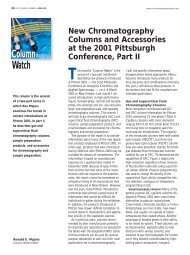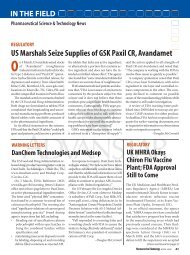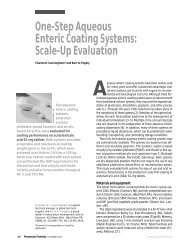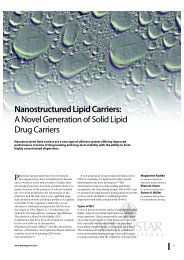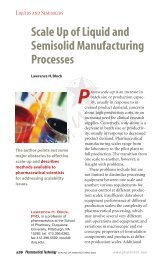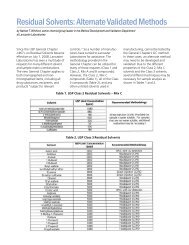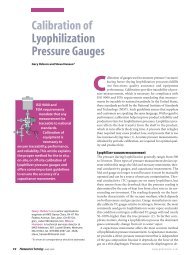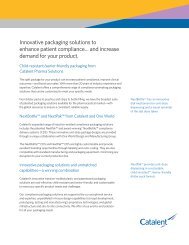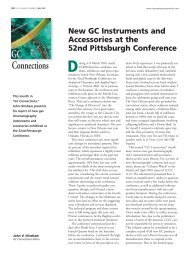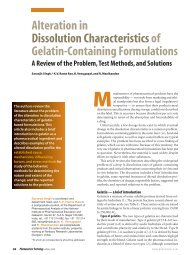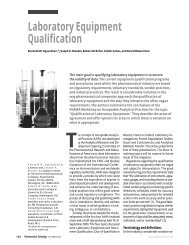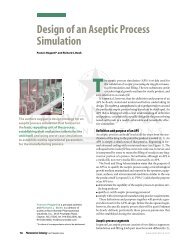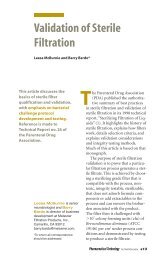Frequently Asked Questions - Pharmaceutical Technology
Frequently Asked Questions - Pharmaceutical Technology
Frequently Asked Questions - Pharmaceutical Technology
You also want an ePaper? Increase the reach of your titles
YUMPU automatically turns print PDFs into web optimized ePapers that Google loves.
There are several different IIG names that might<br />
be associated with a particular Carbopol ® polymer<br />
grade as outlined in the table. It should be noted<br />
that the new USP/NF names (after January, 2006)<br />
applicable to carbomer homopolymers might also<br />
be used for regulatory submission purposes.<br />
Product Trade Name<br />
IIG Name<br />
Carbopol ® 71G NF Polymer Carboxypolymethylene; Carbomer 941<br />
Carbopol ® 971P NF Polymer Carboxypolymethylene; Carbomer 941<br />
Carbopol ® 974P NF Polymer Carboxypolymethylene; Carbomer 934P;<br />
Carbomer 974; Carbomer 974P<br />
Carbopol ® 934P NF Polymer<br />
Carboxypolymethylene; Carbomer 934P<br />
8. How does the drug release mechanism from Carbopol ® polymer matrix tablets compare with that of linear, hydrophilic<br />
polymers (hypromellose)?<br />
The drug release mechanism from Carbopol ® polymers and linear, (soluble) hydrophilic polymers is similar in that both are forming<br />
hydrophilic matrices. In the case of soluble drugs, the predominant drug release mechanism is diffusion through the gel layer.<br />
While in the case of low solubility drugs, the predominant mechanism is polymer relaxation or erosion.<br />
Unlike linear, hydrophilic polymers, Carbopol ® polymers are chemically crosslinked. As a result, they are able to form gels at lower<br />
concentrations than linear polymers. Linear polymers form gels through virtual crosslinking (chain entanglement), and higher<br />
polymer levels are usually required to obtain extended release properties. Additionally, Carbopol ® polymers do not dissolve, but<br />
only disperse/swell in aqueous environments.<br />
9. What is the relationship between Carbopol ® polymer viscosity and drug release rate?<br />
Drug release from Carbopol ® polymer matrix tablets is controlled more by the polymer structure (crosslink density) than by<br />
viscosity. Lightly crosslinked polymers have fewer crosslink sites to constrain the polymer, and a homogeneous gel structure<br />
forms at lower concentrations compared to highly crosslinked polymers. As a result, the active is less subject to diffusion through<br />
the gel layer.<br />
In contrast to linear polymers, higher viscosity does not result in slower drug release with carbomers. Lightly crosslinked<br />
carbomers such as Carbopol ® 971P NF polymer (lower viscosity) are generally more efficient in controlling drug release than highly<br />
crosslinked carbomers such as Carbopol ® 974P NF polymer (higher viscosity).<br />
10. In comparison with hypromellose, what are the typical levels of Carbopol ® polymer that are used to obtain extended<br />
release properties?<br />
For powder grade Carbopol ® polymers (Carbopol ® 971P NF and 974P NF polymers), typical usage levels are 3 – 10% wt. In<br />
comparison, typical usage levels of hypromellose are 20 – 40% wt.<br />
The granular grade, Carbopol ® 71G NF polymer is typically used at 10 – 30% wt. in direct compression formulations or when<br />
added extragranularly. Powder grades of Carbopol ® polymer are more efficient in extending drug release than the granular grade<br />
due to the larger surface area (faster hydration), thus lower levels of polymer are generally needed.



